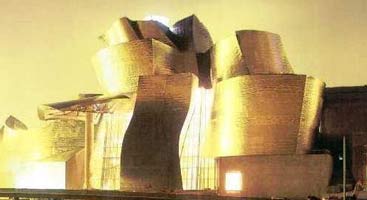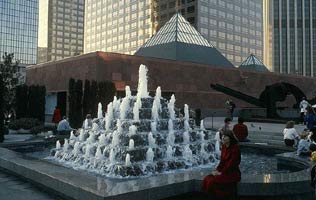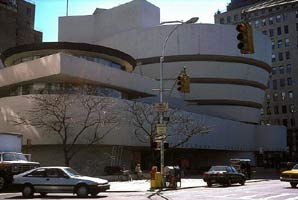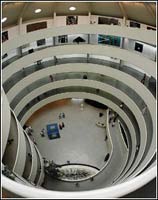|
|
|||||||||||||||||||||

The 1990s and the year 2000 are witness to an incredible proliferation of museums: world architects compete for fantastic amounts of money, capital is reserved by city councils and state associations in Western Europe and America for the third millenium deal-of-a-lifetime in culture, from Texas to Boston, from Helsinki to Berlin. In the heart of the city of Berlin, from 2000 on, five museums will be rebuilt--the cost of such a project is estimated at DM 2 billion. According to various reports, never before have such a quantity of museums and galleries, at such a rate of financial support, been constructed. The triumph of the museum is very real, and thus it is perhaps more appropriate to ask, reversing the title, does, the Western museum of modern art need art anymore?
Museums are among those structures that institutionalized the processes of art and culture in a way that allows us to think about art as an institution. Museums have codified and structured art-regulating the public sphere of need, production and consumption in art. Relations of power have been redistributed, and the audience in art today has been transformed from res nulius, from something which belonged to no one, into res publica, a public affair, which must be accounted for in every serious analysis of modern art. Not only because of the new tourist logic of the museums, but because of new art production in the changing (local) map of Europe, Asia, Africa and so on, museums have to reflect the establishment of new relations of power between the urban periphery, the center and the institutions.
The question "does contemporary art need museums anymore" would perhaps suggest that it is time to bridge the gap between art and life, transcending Art as the institution of power, bringing it down to earth, making it direct and real. But outside the corrupted "institution of art" there is no authentic, unspoiled reality of life! Even "community" is an institution of stratified power relations and dynamics. The institution of modern art, including the whole spectrum of hierarchic relations embodied in it, shows something more: that our historical ideas about how we construct the museum are clearly vanishing in the face of this new situation.

Does this imply the death of the museum, as has been proposed in post-structural theory? On the contrary, as Peter Weibel has stated, it means the end of the historical definition of the museum! This conclusion of definition (that has nothing to do with the end of the museum, which, as it seems, will live eternally) should be viewed in the context of a complex set of complementary oppositions: between reality and its fantasmatic support, between law and its inherent transgression. A fantasmatic scenario permits the thing under discussion to survive unchanged in the face of everyday reality, preventing the passage to real action and change. Herein lies the power of fantasy.
Today we are witnesses to a change in the historical definition of the museum, connected with the fictionalization of history. The museum was once perceived as a "natural" site, but with new projects and media-oriented artworks that integrate the public as a fundamental element of the work, we recognize the artificial social construction of the site of art. The museum is an extension of art, but an artificial one! In the 1970s the museum possessed a kind of spectral power -indestructible also in the case of its potential symbolic destruction, but the museum of 2000 constantly asserts its real power: definitely vulgar, cold, manipulative and almost deprived of any aura. The museum today, especially the museum of (modern) art in the Western world (North America, Japan, etc) is well aware of its own financial, economical and symbolic power-we need think only of the millions that are invested in reorganizing, building, and rebuilding museums. In the 1970s, the museum was perceived as a threat to the art community, with its historical and chronological time classifications and with the development of the idea of constant progress in art and culture, marked by styles and trends. The museum was seen as a place of restriction and power, which dominated the field and provoked violently the conceptual and neo-avantgarde art world to undermine it. The new situation in the 1990s, when the museum asserts visibly and transparently its power and connection to capital, money, architecture, is a process that can be described as the bringing to light and acting out of the underlying fantasy of the 1970s! This situation is much more threatening to the social and symbolical sphere of art perceived as an Institution than the spectral power of the museum of the 1970s. The new museum structure threatens art precisely by way of directly and brutally acting out in the reality of the art and social Institutions. This directness is a cynical gesture: it is as if the museum, as an institution, is giving directly to the art world what this world has hallucinated for decades, and it seems today that this is the most effective way to distort the art world. Constructive diversion or sabotage of the museum as an institution of power is simply not possible, because a coordinated international action, based on solidarity against Art--as an Institution--is likewise not possible.


As a consequence of the ready-made, the system of galleries and museums changed the modalities of the artistic function. The content of a ready-made is not the concrete object, but its context - i.e., the art gallery or museum. The object of the ready-made is the gallery system itself. The birth of the ready-made allowed galleries and museums the monopoly of evaluating the work of art in society. The fact that the ready-made was accepted as a work of art is the purest sign of the real power of the system of galleries and museums in society--from that moment on, this relation has remained unchanged. In this displacement from reality to a fantasized universe, the status of the obstacle changes: in the 1970s, the obstacle, the failure is/was inherent (the relation between the museum and the neo-avantgardist movement in art simply does/did not work). In the second half of the 1990s, this inherent impossibility is externalized into the positive obstacle which from the outside prevents its actualization: history, progress, chronological time are now seen through anti-historical views. And this move, from inherent impossibility to external obstacle, is the very definition of fantasy, of the fantasmatic objective position in which the inherent deadlock acquires positive existence! Ahistorical exhibitions, ruptures with styles, trends, classifications, etc. all work with the implication that with these obstacles cancelled, the relationship will run smoothly. The museum is presented as an institution, a self-reflecting historical phenomenon which uses its own means to examine its functions and possibilities in the context of today's multimedia society. When all the chronology and historical concepts come down to earth, then the re-ordering of the museum and gallery space is based on the curator's geniality and taste; they are seen as a possibility for an objective random collective memory (which collective? which memory?) in images and space. This museum structure is no less hallucinatory and no less a spectralization of the fantasmatic scenario of the power of the art institution from the past.
In contrast with the traditional actions of the museum in masking its power structure, when in the 1970s it was sustained only as a fantasmatic spectral entity, the museum today does exactly the opposite: it destroys not itself, but its fantasmatic image/support. The museum openly assumes the role of the devil of transparency, but the paradox of self-exposure and self-transparency tells us that this transparency makes it even more enigmatic. The art community thinks - not wanting to accept this transformation - that behind the cold manipulative surface of the museum, there must exist something else! - Or not?
Let's take as an example the exhibition 2000 + ARTEAST COLLECTION, which was parallel to another simultaneous event in Ljubljana: Manifesta 2000. The process of composing the 2000 + ARTEAST COLLECTION is based on the idea of the dialogue between Eastern and Western EUROPE, with artworks from the 1960s to the present day, and with a focus on works from Eastern Europe and from the so-called conceptual period. In this re-collection of excellent works of art from the EAST of Europe the first questionable point is the method by which some of the works became part of the collection--the price that was offered for some of the works was so small, almost ridiculous for an artwork with a historical past or present, and the whole situation of payment and regulations of displaying the work was blurred. The act was legitimized afterwards with this phrase in the leaflet printed for the exhibition: the artists and their works will be reimbursed over the coming years, if they will really become part of the collection (and if not, they will be returned following the exhibition). Moderna Galerija in Ljubljana knows perfectly well what is doing, in so far as it re-collects artworks from Eastern European artists and not from the so-called Diaspora who, to put it bluntly, can afford a lawyer! The gesture does not quite fit the description of an ethical act. What was merely hinted at in the 1970s, is now "rendered thematic" (Zizek). In the 2000 + ARTEAST COLLECTION, we encounter at its purest this direct staging of perverse fantasies. What is the spectral fantasy of the authority of the art institution? That there is something brutal and vulgar at the very beginning of the constitution of every museum and its collection.
In the 1970s, Harald Szeemann formulated the idea of the open museum; attempts were made to make social contradictions visible in the museum, and consequently to free art from being sentenced to the museum, by connecting it once more with the world outside. The formula phrase was: Art must awaken, museums are prisons! In the 1980s, Harald Szeemann stated: The museum is a house for art! (in Archis, 1988, in a conversation with Rob de Graaf and Antje von Graevenitz ), and moreover… art is fragile, an alternative to everything in our society that is geared to consumption and reproduction… that is why art needs to be protected, and the museum is the proper place for this. The museum is not what it seemed to be - the museum is therefore not a prison! (in Debora Meijer's lecture from 1991). In the 1990s, and at the beginning of the millenium, the catchphrase is: Does modern art need museums anymore - rhetorically announcing the potential death of the obscene paternal figure - the museum - in art.
This circularity is based on the impossibility of the museum to encounter itself, its proper position. The "father" is always already dead, castrated - there is no enjoying the Other; the promise of the fantasy is a lure. The figure of the castrated father is the figure of an excessively exuberant father, similar to the figure of today's museums. Museums are so empowered on the surface, with exuberant, excessive architecture, that is almost not necessary to go inside the museum! The overpowered museum, far from being the Real beneath the respectful protective appearance, is itself a fantasy formation, a protective shield. Both institutions, both museums from the 1980s and 1990s, suspend the agency of the symbolic Law/prohibition, whose function is to introduce art into the universe of social reality. The two museums are the opposition between the Imaginary and the Real; the 1980s museum is the protector of an imaginary safety, and the 1990s one (just refer back to Moderna Galerija) is the sign of almost lawless violence. The two museum conditions, the imaginary and real, are what is left, once the paternal symbolic authority disintegrates. What we get are strangely de-realized museums, blind museum mechanisms that en/act immediately, with no delay!
Back to the 2000 + ARTEAST COLLECTION. The second point is that it is highly symptomatic that not a single Slovenian artist was included in the present collection, not even the group OHO who is perceived as the hardcore kernel of the conceptual activity of the 1970s in Slovenia. This is even more problematic since the conceptual movement in the East is, as it is stated by the museum itself, at the core of the 2000 + ARTEAST COLLECTION. Paradoxically enough, since the 2000 + ARTEAST COLLECTION is not produced as a national display, the collection was prepared precisely for the international audience-in other words, Manifesta 3 in Ljubljana. The 2000 + ARTEAST COLLECTION disavowed the Slovenian part entirely, de facto eliminating all art production from the 1960s on. For the sake of the clean power of the institution, the proper internal space was completely disavowed, so that the collection displayed an abstract activity, untouched by the national space. This staged fantasy, constructed as a purely aseptic international presentation, protected the museum and its employees from the national space, and at the same time empowered the museum in the international context.
The museum of 2000 is not a situation opposed to the virtualized world of the museums in all its abstracted versions. On the contrary, the museum of 2000 displays itself as an abstract category, without any kind of problematic exaggeration, with no causality. The refusal of a productive closure (that would imply, e.g., in the case of Moderna Galerija, the selection of artists from the Slovenian space and context) means the refusal to face the mortality of the museum itself! In this case, we are not dealing with the symbolic concealing of the traumatic Real of the context. It is exactly the opposite: the images and acts of utter catastrophe, far from giving access to the Real, function as a protective shield against the Real of the museum and of its abstract and strictly depersonalized situation.
This is why Alexander Brener and Barbara Schurz's action at Manifesta 2000 can be viewed as something beyond just an act of barbarism. One day before the official opening of Manifesta, the official press conference of Manifesta took place in one of the big halls of Cankarjev dom in Ljubljana; when approximately ten people from the organizational core were introducing themselves, ready to take questions from the audience, Brener started to spray-paint on a huge projection screen behind the table around which the Manifesta organizers were seated, "Destroy the neo-liberal art system now!" Then, helped by Schurz, who delivered their written statement, he painted and partly destroyed the conference table. He then lay on top of the table, waiting for the Cankarjev dom security guards to remove him, while they were already removing the screaming Schurz. Brener and Schurz attacked Manifesta within its institutional core - Cankarjev dom. In contrast to the elusive spectral presence of the audience, who tried with questions to undermine and to clarify the position of this international exhibition (some Belorussians asked politely about the border of this New Europe and got an answer that was almost a mockery - something like please do not bother us, the curators -- we did not have enough time to go everywhere), Brener was direct, verbal and physical. It is possible to say that due to Brener's action and his catastrophic scenario, it was possible for the Manifesta organizers to take shelter, to disavow the real concept and results of Manifesta, and therefore to avoid the actual deadlock, the antagonisms, the divisions, the abstractions…of the national/international community. The Manifesta organizers continued the press conference immediately after Brener and Schurz were removed, without a single word of reference to what happened. Here, as Zizek would say, it is possible to see how difficult is to effectively interrupt the ritual of authority that sustains the appearance. It is therefore no surprise that at the end, it was all concluded with a party and a huge amount of food; the conclusion was what the organizers pretended Manifesta to be all along, a common celebratory toast and festivity.
The true horror is not all these benevolent institutions and museums, such as Manifesta,, which protect us from the Brener syndromes, nor Moderna Galerija, which completely disavowed Slovenian art, but exactly the reversal of this situation. The truly suffocating and psychotic experience is that this protective care (that protects in the end only the institution itself) erases all traces of difference under the banner of multiplying identities. Multiculturalism is about multiplication (as was apparent in Manifesta); this is why global capitalism needs particular identities. Manifesta 3 is, in its absolutely abstracted version, the international legitimization of the internal enlightened technocrats of post-socialism (Cankarjev dom, etc.) by international multiculturalists. It manifests a radical discord between the effects of resistance and the institutions and mechanisms of power that provoke them, and the complicity of power, private capital and thought with mastery. Caught in an ideological trap, the museum is forced to stage an external, bloody, aggressive, destructive threat against itself, in order to protect its actual abstract, sanitized situation.
(A longer version of this essay was delivered as a key note at CIMAM Conference - The International Committee of ICOM - The International Council of Museums of Modern Art conference, held at Ludwig Museum Budapest, 22-25 September 2000.)